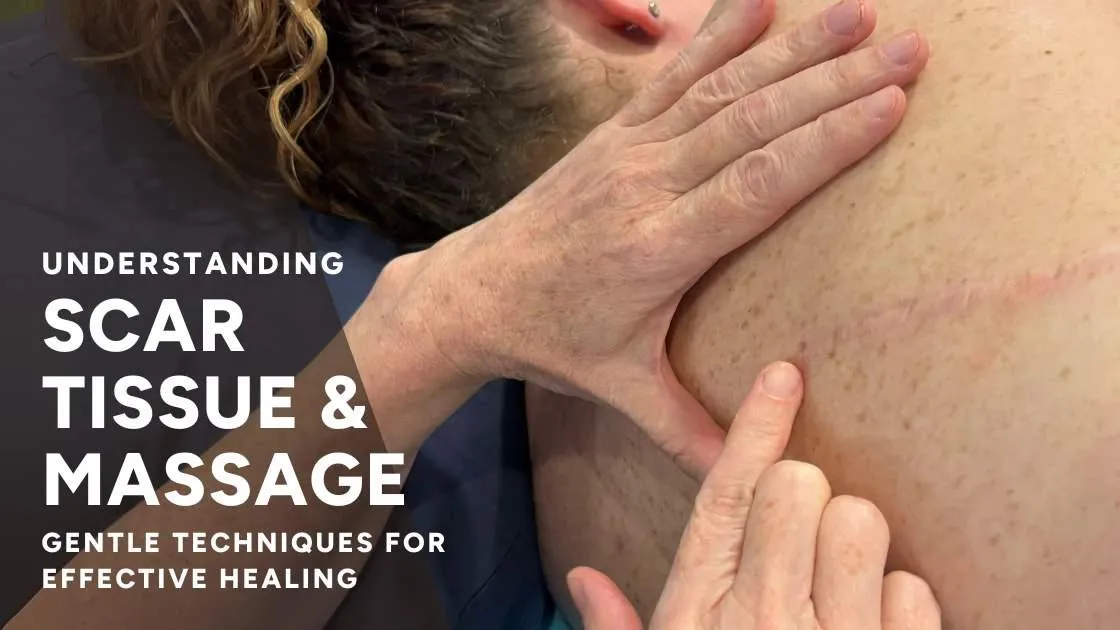
Understanding Scar Tissue and Massage: Gentle Techniques for Effective Healing
Scar tissue is a natural part of the body’s healing process, but its presence can sometimes lead to challenges in mobility, discomfort, and adhesions that interfere with normal function.
Health professionals involved in manual therapy—such as remedial massage therapists, physiotherapists, chiropractors, and others in post-operative care—are increasingly recognizing the vital role that gentle scar massage can play in the recovery process.
Surprisingly, the most effective treatments are often not the firm, deep (and painful) techniques that many of us were taught in mainstream education – if we were taught to treat scars at all!
Research shows that there are gentle approaches which can yield remarkable results in helping to restore mobility, reduce pain, and enhance overall healing.
My personal experience also reflects this – I've found gentle techniques have made a massive difference in my own scars and that of many clients I've treated over the last 14 years.
The Science of How Scars Form
When the body experiences trauma through things like injury, surgery, or burns – it responds by producing collagen, a protein that helps to rebuild tissue. This is exactly what the body is designed to do in order to heal, and it's great!
However, this new tissue doesn’t always have the same structure as the original. Scar tissue tends to form in a disorganized pattern, which is why it looks visually different to the surrounding tissue – and more importantly, it can lead to adhesions and restrictions in movement as the tissue binds to surrounding fascia.
Fascia is the connective tissue that envelops muscles, nerves, and organs, and it plays a crucial role in understanding why scars can cause issues beyond what is visible on the surface.
When scar tissue forms, it can disrupt the normal function of the fascia, leading to tightness and pain.
In some cases, these adhesions also limit range of motion and impair the body's natural biomechanical function.
Gentle Scar Therapy: Why Less is Often More
One of the most surprising findings in scar tissue treatment is the efficacy of gentle massage techniques.
While it might seem counterintuitive, applying too much pressure can actually exacerbate discomfort, further restrict the tissue, and in some cases even cause the creation of more scar tissue.
Whereas, gentle techniques that work with the body’s natural healing mechanisms have been shown to be equally – if not more – effective than more aggressive methods.
This insight has been echoed by experts such as Gayle MacDonald in "Medicine Hands: Massage Therapy for People with Cancer," where she discusses the value of soft-touch therapies for healing, particularly in vulnerable patients.
Nancy Kennan Smith and Catherine Ryan, in "Traumatic Scar Tissue Management," further explore how subtle movements and light pressure can effectively remodel scar tissue and help release adhesions without causing additional trauma to the area.
In a Gentle Scar Therapy workshop I ran this week, a massage therapist who herself has a scar shared an experience where her physiotherapist recommended scar massage post-surgery. She admitted that she was surprised by the recommendation and felt that as a trained massage therapist herself, she should have known more about this.
This reflects a growing trend: health professionals, including physiotherapists and surgeons, are more frequently recommending scar massage as a critical part of post-operative care.
And it also reflects another truth I hear quite often – that manual therapists themselves have often not been taught how to treat scars at all, or have not been trained effectively enough to be confident.
How Scar Massage Works: Addressing Adhesions and Fascia
Traditional scar massage techniques are very firm and use terms like "breaking down" the tissue or adhesions. When I was taught these techniques I was told to use the term "challenging to the tissue" which basically means it is painful to receive!
However, gentle techniques which use a very soft touch produce benefits through increasing blood flow, creating space, integrating awareness of the scar and encouraging the collagen fibers to realign in a more organized manner.
This can lead to a greater range of motion, reduced tightness, and a decrease in pain.
For example, Jan Trewartha and Sharon Wheeler, in their work "Scars, Adhesions and the Biotensegral Body," highlight how specific manual therapy techniques can assist in reorganizing scar tissue to better integrate with the surrounding tissues.
And in my experience one of the key components of successful scar therapy is working with the fascia.
Fascia is incredibly sensitive to both pressure and movement, and gentle techniques can help to release fascial restrictions caused by scar tissue.
As "The Endless Web: Fascial Anatomy and Physical Reality" by R. Louis Schultz and Rosemary Feitis explains, fascia is a continuous structure throughout the body, so pain and restriction can often be felt in areas distant to the scar site.
Which is why treating a scar in one area can often have a ripple effect on overall mobility and function, and can relieve pain felt in other areas of the body.
Why Gentle Scar Massage Techniques Are Effective
There are several reasons why gentle techniques are so beneficial:
Reduced Trauma to the Tissue: When scar tissue is massaged too aggressively, it can cause further micro-trauma, leading to inflammation and delayed healing. Gentle techniques minimize this risk, allowing the body to heal without additional stress.
Reduced Trauma to the Patient: Many scars are created by something associated with psychological trauma at some level, so if a treatment is painful it can be triggering for the patient. These people have been through enough already and I don't want to re-traumatize them.
Lower Defenses: Firm pressure can sometimes trigger the body’s defensive response, causing muscles and fascia to tense. Gentle techniques encourage relaxation, making it easier for the therapist to work with the tissue and for the client to experience relief.
Fascial Release: Gentle, sustained pressure allows for the gradual release of fascial restrictions. This process is essential for improving mobility and function in areas affected by scar tissue. Research has shown that fascia responds well to light touch and slow movements, making these techniques ideal for treating scars and adhesions .
Comfort: Painful treatments can create a negative feedback loop, where clients become apprehensive about the therapy and tense up during sessions. Gentle scar massage techniques are not only more comfortable for clients but also more likely to lead to positive outcomes and long-term compliance with treatment.
The Growing Recommendation for Scar Massage
Many professionals in post-operative care are now recognizing the value of scar massage as part of the rehabilitation process.
The World Health Organization highlights the importance of comprehensive care following surgery or injury, and scar massage can play an integral role in promoting tissue healing, improving mobility, and reducing pain.
In the U.S., burn care centers are increasingly incorporating scar massage into their treatment protocols to support long-term recovery .
In conclusion, scar tissue massage, particularly when approached with gentle techniques, is a highly effective modality for improving function, reducing discomfort, and enhancing overall healing.
As more health professionals recommend this form of treatment, it is essential for manual therapists to expand their understanding of the science behind scar formation and the benefits of gentle fascia-focused therapy.
For those looking to deepen their expertise in this area, Christine Knox’s gentle scar therapy workshops offer hands-on training and advanced insights into the subtle yet powerful methods for treating scar tissue. Whether you're a massage therapist, physiotherapist, or chiropractor, this knowledge can transform your practice and help your clients achieve better outcomes.
References:
"The Impact of Scar Tissue Formation on Functional Recovery After Injury" published in Frontiers in Physiology
Traumatic Scar Tissue Management - Massage Therapy Principles by Nancy Kennan Smith and Catherine Ryan
The Endless Web - Fascial Anatomy and Physical Reality by R. Louis Schultz and Rosemary Feitis







